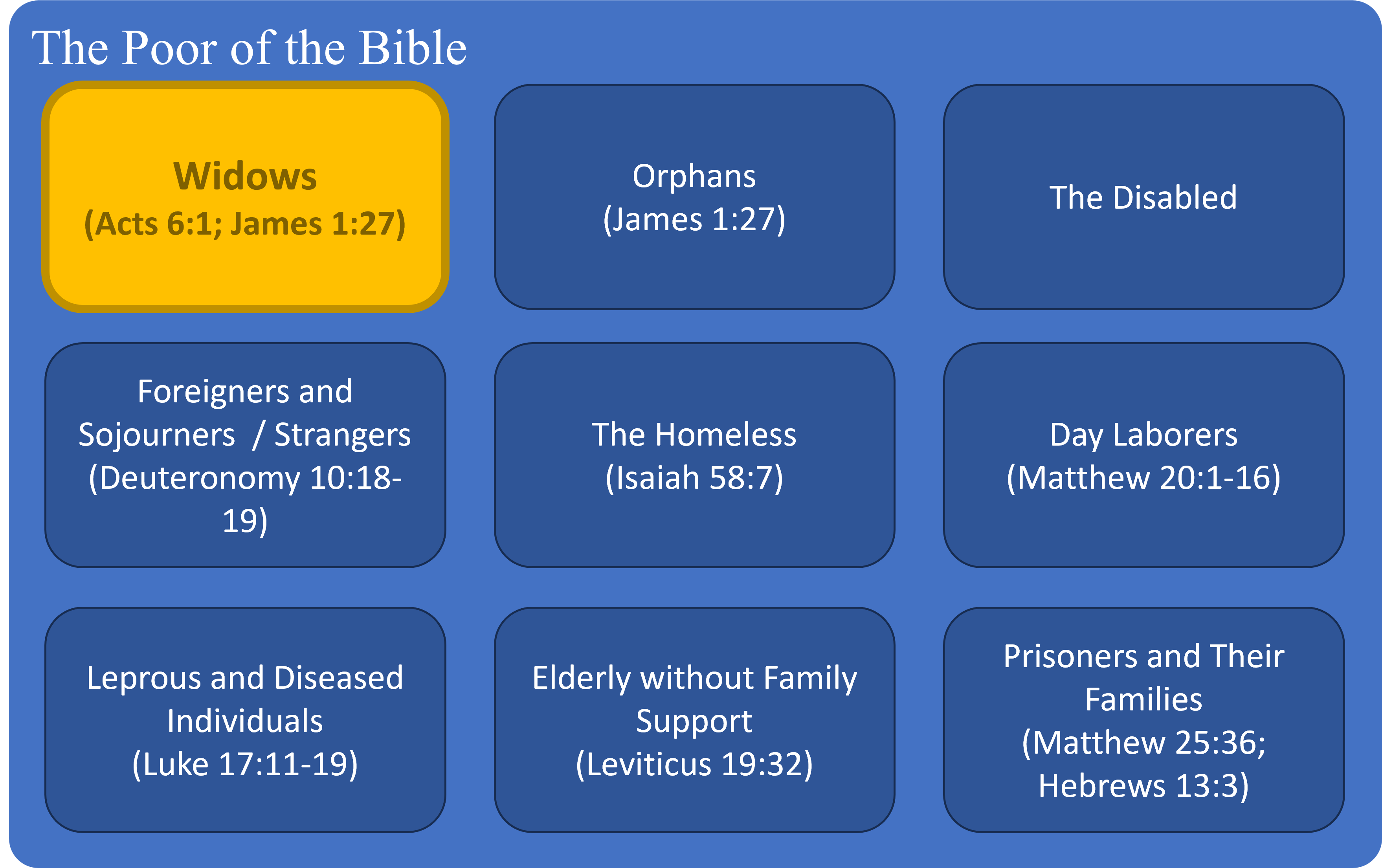Missional Living — Maximizing Your Ministry Part 1 (Acts 6:1-7)
Maximizing Your Ministry Part 1 (Acts 6:1-7)
Introduction
The admonition to care for the poor is found throughout the Scriptures (Exodus 23:10-11; Leviticus 23:22; Deuteronomy 15:7-11; Esther 9:22; Psalm 14:6, 41:1; Proverbs 14:21; Matthew 11:5, 19:21; Romans 15:26; Galatians 2:10; Luke 14:13, 21). Caring for the poor is one way that a person in the community of faith does business with God (Proverbs 19:17) and honors Him. How does showing kindness to the poor honor God? There are at least two reasons why kindness to the poor honors God. First, the poor are made in the image of God (Genesis 1:27; Proverbs 14:31; 22:2); showing kindness to the poor is a way of showing respect for His image (1 John 4:20). Second, rendering compassion to the poor in our fellowships is one way we demonstrate our new birth (1 John 5:1).

Figure 1 – Poor people in the Bible come in many types. Especially important to God are widows (James 1:27).
Within the segment of society regarded as poor there is a subsection that is especially dear to God’s heart: widows and orphans (Exodus 22:22-24; Deuteronomy 10:18; Psalm 68:5; Proverbs 15:25; James 1:26-27). Widows, especially in the time of the first church, were particularly vulnerable to poverty. The agencies of modern governments that care for the poor did not exist. But the early church, under its apostolic leadership, had been mindful of this group. There was a daily distribution of alms aimed at meeting the needs of widows. This distribution to the widows had worked for a while; it had been effective when the church was fairly homogenous. But with exponential growth in the fellowship came a corresponding diversity in the demographics. The church is now comprised of local Jews and those that have immigrated to Jerusalem. The local Jews speak Aramaic (or Mishnaic Hebrew). Those that have immigrated to Jerusalem are called Hellenists (Acts 6:1). Who are the Hellenists and how do they differ from the Hebrews? F.F. Bruce summarizes:
The church of Jerusalem, we are now told, comprised both “Hebrews” and “Hellenists.” The main distinction between the two groups was probably linguistic: the Hellenists were Jews whose habitual language was Greek and who attended Greek-speaking synagogues; the Hebrews spoke Aramaic (or Mishnaic Hebrew) and attended synagogues where the service was conducted in Hebrew. Many of the Hellenists had affinities with the lands of the Jewish dispersion around the Mediterranean shores, whereas the Hebrews were Palestinian Jews; there were doubtless several minor social and cultural differences between the two groups. In the Jewish world as a whole there were tensions between them, and some of these tensions endured between members of the two groups who had joined the “disciples” (Bruce, 1988, p. 120).
The Hellenists are Jews of the Diaspora that have assimilated some aspects of Greek culture – especially language. Arnold G. Fruchtenbaum, in his commentary on Acts explains that their was a grievance growing among the Hellenists against the Hebrews:
[W]hile the church was deeply concerned about taking care of the widows, there seems to have been a prejudice in favor of the locally born, Hebrew speaking widows, over the Greek speaking widows who had immigrated into the country. The latter felt neglected and overlooked in the daily distribution (Fruchtenbaum, 2005, Kindle Locations 2723-2725).
Out of the growth caused by the ministry of the word (Acts 5:42) came diversity. Out of the diversity arose discrimination and inequity. In order to deal with inequity and discrimination there would need to be an intervention by the apostles. The handling of the matter by the twelve contains principles of missional living that are sorely needed by many fellowships and individuals today. If we are willing to listen to the voice of the early church apostles, our ministries, personal and corporate, can become more efficient and more effective. The twelve tell us to concentrate on our calling, delegate duties, and then watch God work.
Questions for Personal Study
- Are there indicators that your ministry is operating below its potential? This could be seen in missed opportunities due to obligations outside your calling or quality that is lower than what you are capable of?
- Has anyone shared with you criticism concerning your ministry that could be useful in looking for places to improve?
- Do you desire to raise the quality of your ministry and the quantity of people reached?
References
Bruce, F. F. (1988). The Book of the Acts. Grand Rapids, MI: Wm. B. Eerdmans Publishing Co.
Fruchtenbaum, Arnold G (2005). Commentary Series: The Book of Acts. Ariel Ministries.
Notes
The women seen in the featured image of this post were at a conference in Atlanta. Immediately to my right is Yvonne. Across the table is Virgina. I was there for the company owned by my wife and I, BIF Technologies, on business with Xtreme Solutions. After our respective work we met over prayer, the Scriptures, and worship in a public setting. We endeavored to (1) be above reproach and (2) make the most of the moment. Maximizing your ministry may be as simple as using moments that seem secular for purposes sanctified.

